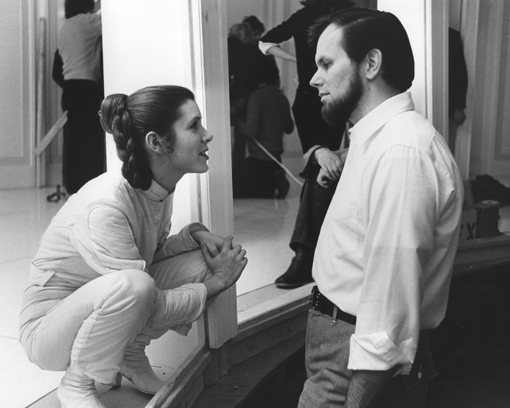
The Kurtz/Joiner Archive is the collaboration of Gary Kurtz (Star Wars producer /filmmaker and vice president of Lucas film up until 1981) and Jason Joiner (Collector and Guinness world record holder for the largest Star Wars collection and film historian) In 1991 they met at Gary’s production offices in London to talk about Gary’s work on the Star Wars films. Jason had been interviewing crew members for the previous two years in an attempt to preserve and record as many of the crew’s memories as possible for future generations of fans. When they met, it was a genuine meeting of minds, as Gary really liked that Jason was finding out the real history from the crew that made the films. Jason was amazed by how much knowledge Gary had retained and soon realised that Gary was not a normal film producer; he was someone that gave up years of his life to live, work and breathe Star Wars for around 8 years. Gary did not just produce the films as a job; he gave over his life to creating them like one would bring up a child. Jason could tell that Star Wars had meant, and still did mean, a lot to Gary. After that meeting Gary helped Jason with his project to interview as many cast members as he could, which in the end totaled over 350 crew members.
One day Jason was talking to Gary about a 4-Lom mask that he had bought, and Gary talked about all the items he had kept from the past. It came up that there was a large storage room full of paperwork, photos, drawings and props. In fact, a lot of Gary’s life had been stored in boxes, never opened since the day they made it to that storage room. As Jason had been gathering items, just as Gary described, for the past 7 years, this collection was of great interest to him and so he asked to visit the storage room. Gary agreed and Jason went to the US to take a look. Upon arrival it was soon apparent that Jason had a difficult task ahead of him; the storage room was crammed from ceiling to floor with storage boxes, all brimming full of paperwork from Gary’s films. This was a whole new and exiting world for Jason, for in that one room there was more information about the films than he had learnt in over 3 years of meeting people.
Jason came back to the UK and talked to Gary at length about what to do with all of his material; it would need to be catalogued and looked after if it were to be preserved. It would also be amazing for Jason to have the opportunity to go through the paperwork to put it into order. Everything would need to be scanned andtransferred to other formats so that there were back ups of this unique and un-seen history. Jason knew it would be a big job that would take many years to complete, but he felt it was something he had to do. Gary saw that Jason cared as much as he did about the history of the films and felt that Jason was the person to look after, and be responsible for, this material. It was at this time that Gary and Jason came up with the idea of creating an archive to preserve and collect material relating to Gary’s films. And so Gary’s collection was added to Jason’s collection and the Kurtz/Joiner Archive was born.

The Archive has come a long way since then, but there is still lots more work to do. Lots of the work is ongoing, but the archive is now housed in a 5000 foot warehouse outside London, England. It consists of tons of paperwork, 10’s of 1000s’ of images, most that have never been seen by the public, as well as 1000’s of blue prints and ticker tape messages from Lucas film US to EMI Elstree Studios over the entire UK film production time. Some of the information kept in the archives is also unique, as a flood at Lucas film in the early years destroyed much of their paperwork from the late 70s. Treasures such as Alec Guinness’ signed contract for Star Wars, possibly the only original contract to survive, can all be found in the archive. The archive also contains Gary’s personal copies of everything he did with Lucas Film and Jim Henson, and spans his entire film career to date including his work from his USC Film School days through to Star Wars, Dark Crystal, Return to Oz, and his current projects.
The Archive is openly gathering and buying items it feels it needs to cover the story of the making of the films Gary worked on. If items come their way that are not already contained within the Archive they are very keen to obtain them. They buy or are given around 50 to 100 items a year that they feel are important to the history of Gary’s films, and they hope for it to continue growing long into the future.